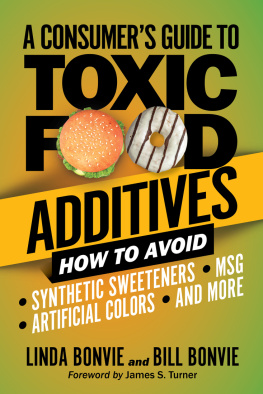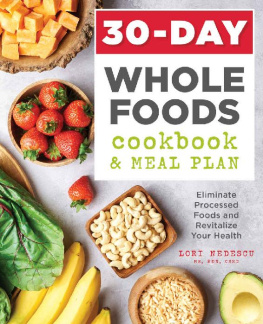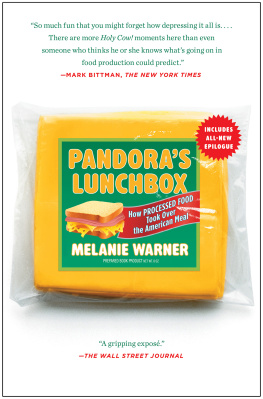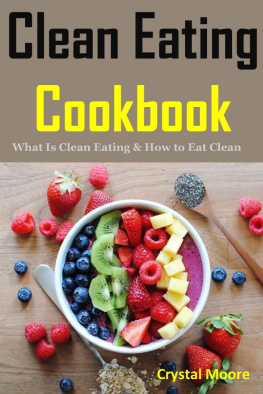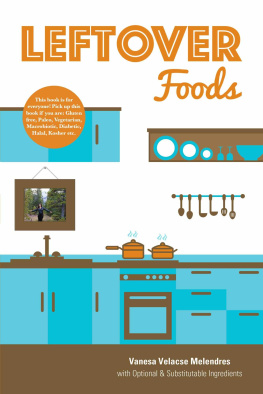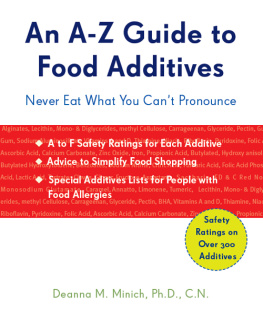Twinkie, Deconstructed
Twinkie, Deconstructed
My Journey to Discover How the Ingredients Found in Processed Foods Are Grown, Mined (Yes, Mined), and Manipulated into What America Eats
Steve Ettlinger

HUDSON STREET PRESS
Published by Penguin Group
Penguin Group (USA) Inc., 375 Hudson Street, New York, New York 10014, U.S.A. Penguin Group (Canada), 90 Eglinton Avenue East, Suite 700, Toronto, Ontario, Canada M4P 2Y3 (a division of Pearson Penguin Canada Inc.) Penguin Books Ltd., 80 Strand, London WC2R 0RL, England Penguin Ireland, 25 St. Stephens Green, Dublin 2, Ireland (a division of Penguin Books Ltd.) Penguin Group (Australia), 250 Camberwell Road, Camberwell, Victoria 3124, Australia (a division of Pearson Australia Group Pty. Ltd.) Penguin Books India Pvt. Ltd., 11 Community Centre, Panchsheel Park, New Delhi110 017, India Penguin Books (NZ), cnr Airborne and Rosedale Roads, Albany, Auckland 1310, New Zealand (a division of Pearson New Zealand Ltd.) Penguin Books (South Africa) (Pty.) Ltd., 24 Sturdee Avenue, Rosebank, Johannesburg 2196, South Africa
Penguin Books Ltd., Registered Offices: 80 Strand, London WC2R 0RL, England
First published by Hudson Street Press, a member of Penguin Group (USA) Inc.
Copyright Steve Ettlinger, 2007
All rights reserved
 | REGISTERED TRADEMARKMARCA REGISTRAD A |
LIBRARY OF CONGRESS CATALOGING-IN-PUBLICATION DATA
Ettlinger, Steve.
Twinkie, deconstructed: my journey to discover how the ingredients found in processed foods are grown, mined (yes, mined), and manipulated into what America eats / Steve Ettlinger.
p. cm.
ISBN 978-1-1012-1368-1
1. Food additives. 2. Processed foods. 3. Twinkies (Trademark) I. Title.
TX553.A3E85 2007
641.3'08dc22
2006030013
Without limiting the rights under copyright reserved above, no part of this publication may be reproduced, stored in or introduced into a retrieval system, or transmitted, in any form, or by any means (electronic, mechanical, photocopying, recording, or otherwise), without the prior written permission of both the copyright owner and the above publisher of this book.
PUBLISHERS NOTE
The scanning, uploading, and distribution of this book via the Internet or via any other means without the permission of the publisher is illegal and punishable by law. Please purchase only authorized electronic editions, and do not participate in or encourage electronic piracy of copyrighted materials. Your support of the authors rights is appreciated.
To Dylan and Chelsea
and
To those of us who have spent many a dull
moment staring, uncomprehending, at the
ingredient list on the label of some packaged
food (you have plenty of company).
Now you can read this book instead.
Tell me what you eat,
and I will tell you what you are. Jean Anthelme Brillat-Savarin
The Physiology of Taste
ACKNOWLEDGMENTS
F irst and foremost, Im grateful to my children, Chelsea and Dylan, who served as inspiration for this book and who share my fascination with kitchen and consumer product science. (Kids, sorry for such a long answer.) Thanks beyond the norm go to my wife, Gusty, who encourages and knows creativity, drive, hard work, long hours, and passion. Thats what it takes. The emotional support of my family was backed up with practical sacrifices that made it all possible, to their credit. My mother applied her editorial skepticism, artfully blended with motherly encouragement, for which Im especially grateful. (In my world, family and work go together.)
Id like to thank my teachers, from elementary school through college, for encouraging me to investigate and to write, for which I am ever in their debt. They shaped my life. I remember each and every one of you, though Id like especially to acknowledge Gerald Grunska for the basics and Frank Colcord, Ph.D., for encouraging my first big project.
My agent, Brian DeFiore, came on board at a key time and made this book happen. (Thanks again to my then eight-year-old, ice-cream-eating daughter, who introduced us.) And vigorous thanks are due to my dedicated, supportive, and superbly articulate editor and dynamite publisher, Laureen Rowland, whose early enthusiasm for the book and zinging editorial memos served me well over the long days and late nights it took to research and write the book. Writers need teammates like these.
One of the most important sources for the emotional fuel behind this book was the encouragement of friends, whether editorial or logistical. Included are at least these, with apologies to those not listed: Tom and Mary Kerr, Eddy and Barbara Sucherman, John and Joan Von Leesen, Jan and Stan Tymorek, William Abrams, Julie Salamon, Heidi Hansen, Heather Heath Reed, Shino Tanakawa, Jill Enfield, Richard Rabinowitz, Steven Schram, Ph.D., George LaGassa, Roy Simon, John Smallwood, David Rubel, American Book Producers Association, PS 3, and the board of PS 3 til 6, Inc. You all supported and encouraged me in myriad ways, for which Im especially grateful.
A note regarding those who helped me in professional capacities is found at the end of the book.
CONTENTS
A NOTE TO THE READER
O ne could be forgiven for thinking that all one might have to do to find out what goes into a Hostess Twinkies Golden Sponge Cake with Creamy Filling is to simply ask the company that makes them. But it is not that simple.
In fact, Interstate Bakeries Corporation, one of the countrys largest wholesale bakeries, which owns Hostess, Drakes Cakes (Yodels, Devil Dogs, Yankee Doodles, and Ring Dings), Wonder Bread, Home Pride, Dolly Madison Bakery, Butternut, Merita, and Cottons Holsum, among other familiar brands, was initially receptive to my requests for tours and interviews. However, after about twenty-four hours of contemplation, the company declined via phone, citing its preference to help writers who are merely reminiscing about their sweet childhood memories.
Despite this, Interstate could not have been nicer or more professional, and for that I am very grateful. (Plus, I got to speak with someone who has what must be the most fabulous business title ever: Vice President of Cake.) So the information on Twinkies and their ingredients comes from publicly available sources, industry professionals, and academics, but not directly from Hostess/ Interstate Bakeries.
In researching this book, I traveled to see many of the ingredients points of origin and processing myself, experiencing firsthand the alchemy of modern food science that turns recognizable commodities like corn and petroleum into anonymous white powders and viscous liquids and then turns those into yellow cakes with creamy filling, among many other familiar foods.
Twinkies, of course, are not the only food products made with these ingredientsthey are just a perfect example. Not only do they contain many of the most common ingredients found in processed foods, they are as familiar to most consumers as a product can be. There are, in fact, some dead-on imitations: Mrs. Freshleys Gold Creme Cakes, Little Debbie Golden Cremes, and Lady Linda Creme Fingers, for starters (Little Debbie actually sells twice as many snack cakes, of all types, as Hostess; but because they are priced more cheaply than Twinkies, both have annual sales of around $200 million). So the functionality of each ingredient is not unique to Twinkies. The same ingredients are found in hundreds of well-known foods, such as salad dressings, ice cream, and breadnot just cakes. Surprisingly, even Ensure nutrition shakes and toothpaste share some of these ingredients.
Many of the food scientists, food science teachers, consultants, and baking professionals I spoke with have worked on creating cakes and creamy fillings over the years for many different clients and were able to share their expertise in general terms, as the cakes all use similar ingredients, though in artfully different ways (the line between art and science is very, very thin here, as it is in most baking). Also, the ingredient and the subingredient manufacturers I spoke with were able to tell me how they make their products and how they are used with continued enthusiasm by a variety of customers, not just Interstate Bakeries. All manufacturers and processes described are examples of what is likely or typical, not exactly what is done to make Twinkies proper.
Next page

